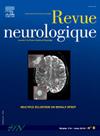颞叶癫痫网络的不同亚型。
IF 2.3
4区 医学
Q2 CLINICAL NEUROLOGY
引用次数: 0
摘要
颞叶癫痫(TLEs)是外科评估中最常遇到的癫痫形式之一,其特点是具有多种解剖、功能和临床电学亚型。立体脑电图(SEEG)的发展拓宽了传统的分类,如中线和外侧 TLE,揭示了更复杂的形式,如中线-外侧和颞叶-附加癫痫发作。这些发现支持致痫网络的概念,强调癫痫发作的起源是相互关联的区域而非孤立的病灶区域。致痫指数(EI)等定量工具正在提高 SEEG 解读的准确性,而 SEEG 解读与手术结果密切相关。尤其是颞叶附加癫痫,由于其更广泛地参与网络,因此需要对 SEEG 进行全面探索,从而采取量身定制的手术方法。更好地了解TLEs亚型和致痫网络是推进激光间质热疗(LITT)和神经调控等微创手术技术的重要基础。这些方法依赖于致痫网络的精确定位。这种基于网络的框架是优化手术效果和推进个性化癫痫治疗的重要一步。本文章由计算机程序翻译,如有差异,请以英文原文为准。
The different subtypes of temporal lobe seizures networks
Temporal lobe epilepsies (TLEs) are among the forms of epilepsy most frequently encountered in surgical evaluations, characterized by a wide range of anatomical, functional, and electroclinical subtypes. Traditional classifications, such as mesial and lateral TLE, have been broadened by advances in stereoelectroencephalography (SEEG), revealing more complex forms such as mesio-lateral and temporal-plus seizures. These findings support the concept of epileptogenic networks, emphasizing interconnected regions rather than isolated focal areas in the genesis of seizures. Quantitative tools, such as the epileptogenicity index (EI), are improving the accuracy of SEEG interpretation, which is closely correlated with surgical results. Temporal-plus epilepsies, in particular, require full SEEG exploration due to their broader involvement in the network, necessitating tailored surgical approaches. A better understanding of TLEs subtypes and epileptogenic networks is an essential basis for advancing minimally invasive surgical techniques, including laser interstitial thermal therapy (LITT) and neuromodulation. These methods rely on the precise localization of epileptogenic networks. This network-based framework represents an important step towards optimizing surgical outcomes and advancing personalized epilepsy care.
求助全文
通过发布文献求助,成功后即可免费获取论文全文。
去求助
来源期刊

Revue neurologique
医学-临床神经学
CiteScore
4.80
自引率
0.00%
发文量
598
审稿时长
55 days
期刊介绍:
The first issue of the Revue Neurologique, featuring an original article by Jean-Martin Charcot, was published on February 28th, 1893. Six years later, the French Society of Neurology (SFN) adopted this journal as its official publication in the year of its foundation, 1899.
The Revue Neurologique was published throughout the 20th century without interruption and is indexed in all international databases (including Current Contents, Pubmed, Scopus). Ten annual issues provide original peer-reviewed clinical and research articles, and review articles giving up-to-date insights in all areas of neurology. The Revue Neurologique also publishes guidelines and recommendations.
The Revue Neurologique publishes original articles, brief reports, general reviews, editorials, and letters to the editor as well as correspondence concerning articles previously published in the journal in the correspondence column.
 求助内容:
求助内容: 应助结果提醒方式:
应助结果提醒方式:


